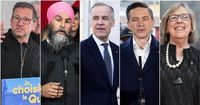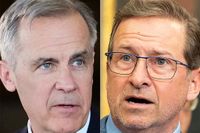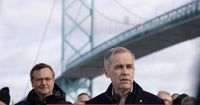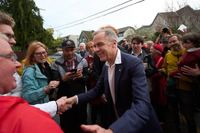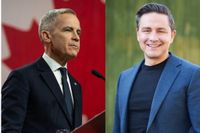As the 2025 federal election campaign heats up, the political landscape in Canada is shifting dramatically, with the Liberal Party of Canada, led by Mark Carney, surging ahead of the opposition. Recent polling data from multiple sources indicates that the Liberals are poised to secure a majority government, with significant support across the nation, particularly in Quebec and British Columbia.
According to polling and analytics firms, including Research Co. and 338Canada, the Liberals are projected to win 44% of the popular vote, significantly ahead of the Conservatives, who are expected to garner around 36%. The New Democratic Party (NDP) trails with only 8%, while the Bloc Québécois stands at 6%. These numbers reflect a broader trend observed since the start of the campaign, where the Liberals have gained ground while their opponents have slipped.
Mark Carney's approval ratings are notably high, with 58% of Canadians expressing support for his leadership. This places him well ahead of Conservative leader Pierre Poilievre, who has an approval rating of 44%, and NDP leader Jagmeet Singh at 40%. In Quebec, the situation is particularly dire for the Bloc Québécois, which has seen its support plummet to just 19%, putting it in third place behind both the Liberals and Conservatives.
The data suggests that voters are increasingly prioritizing federal leadership on issues such as Canada-U.S. relations, which 31% of likely voters identified as the most pressing concern. This is followed by the economy and job stability at 19%, and housing, homelessness, and poverty at 18%. Carney's strong stance on these issues appears to resonate with voters, further solidifying his position as a leading candidate.
In Quebec, the Angus Reid Institute recently reported that the Liberals hold a seven-point lead over the Bloc, a stark contrast to previous elections where the Bloc was a dominant force. Polls indicate that the Liberals could win an average of 49 seats in Quebec, compared to the Bloc's projected 16 seats. This shift is alarming for the Bloc, which could face significant losses if current trends continue.
The implications of these polling trends are profound. If the Liberals achieve the projected numbers, it would mark their best performance in over forty years. However, political analysts caution that the election is still weeks away, and voter sentiments can shift rapidly. The NDP, which won 25 seats in the 2021 election, is now projected to secure only four seats, raising concerns about its viability as a recognized party in the House of Commons.
Jagmeet Singh, despite the disheartening projections, remains defiant. He expressed confidence in his ability to win his riding of Burnaby Central, stating, "Absolutely. I'm confident that I'll be able to serve the people of Burnaby Central." However, many voters, including those in Singh’s own party, are expressing doubts about the NDP's chances, with some indicating they might vote strategically for the Liberals to prevent a Conservative victory.
Former NDP leader Tom Mulcair acknowledged the current election landscape as a two-horse race, suggesting that many traditional NDP supporters are now leaning towards the Liberals in hopes of countering the perceived threats posed by Conservative policies. This sentiment is echoed by political observers, who note that Singh's long tenure as NDP leader without forming a government may be influencing voter decisions.
As the campaign progresses, the focus on key issues like Canada-U.S. relations and economic stability remains paramount. The latest Research Co. poll highlights that 60% of likely voters feel comfortable with Carney managing Canada's economy, compared to only 46% for Poilievre. This perception could play a crucial role in influencing undecided voters as the election date approaches.
In British Columbia, where the NDP traditionally garners strong support, the party's fortunes appear to be waning. Recent surveys indicate that many voters are hesitant to support the NDP due to concerns about the party's ability to win. Al Henry, a Vancouver voter, expressed his frustration, saying, "I just hope Poilievre does not get in," indicating a willingness to vote strategically rather than support a party he feels may not succeed.
Political scientist Sanjay Jeram pointed out that tariffs and the public's desire for their votes to matter are contributing to the NDP's struggle. With Singh being the longest-serving leader among the major parties, there is a growing perception that the NDP has not capitalized on its opportunities effectively, leading to voter disillusionment.
As the campaign enters its final weeks, the stakes are high for all parties involved. The potential for a Liberal majority government looms large, and the Bloc Québécois faces an existential crisis if current trends continue. While the NDP fights to maintain relevance, the Conservatives are left scrambling to regain lost ground.
With the election just around the corner, Canadian voters are preparing to make their voices heard. The outcome will not only determine the future of the federal government but also shape the political landscape for years to come. As polls continue to fluctuate, one thing remains clear: the next few weeks will be crucial for all parties as they seek to sway undecided voters and solidify their bases.
